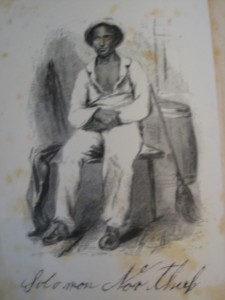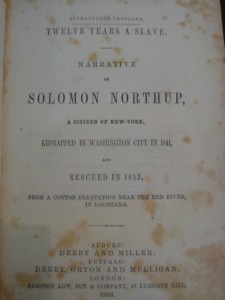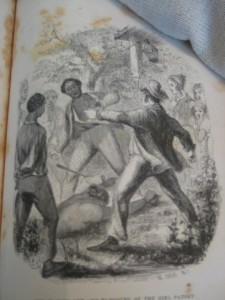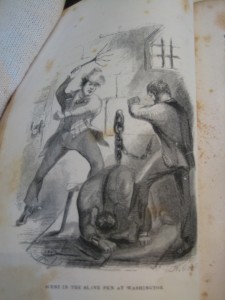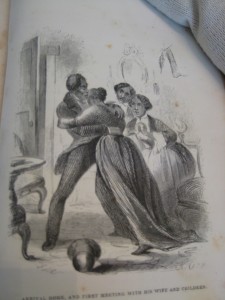In light of recent events, many people know Twelve Years A Slave as an important film about slavery. Yet the origins of Twelve Years is deeply imbedded in not only the history, but also in the literary culture of America.
The genre of the slave narrative is usually assigned the end date of 1865, which coincides with the ending of slavery in the United States, though some also include the dictated stories collected from people that lived into the twentieth centuries via the Federal Writers’ Project around the 1930s (Davis and Gates xii). The person given credit for being the founder of the genre is Olaudah Equiano and his narrative (Doherty 1). Despite the laws and beliefs claiming that black slaves were illiterate and ignorant, their gripping stories of the cruelty of slavery helped the abolitionist cause and were often promoted by anti-slave societies (Davis & Gates xvi). Naturally they garnered opposition from slave owners and plantation owners from the South, who responded by making up a genre of their own. The Plantation novel was conceived by the planters to show a rosy view of plantation life in an attempt to discredit slave narratives (xvi).
The slave narrative gave the opportunity to tell the world what slavery was like, however they were not able to entirely say what they wanted to say (79). Narratives were often dictated to white and written down by white editors (79). The beliefs, educations and attitudes towards slavery effect what events were recorded in the narrative (79). Nevertheless, editors often were also journalists, lawyers, teachers, etc. used to dealing with facts and stories (79). They were also “…noted for their integrity (79), adding to the credibility of the narrative itself. However, many had no ties to abolitionists or were hostile to the movement, as seen with David Wilson, Northup’s editor (79-80), though Wilson was not hostile to the abolitionist cause, he was just interested in publishing the narrative and it is unknown if he change his attitude towards it (Eakin and Logson xiii). It is also interesting to note that Northup himself was able to read and write, being a freeman first (Eakin and Logson xvi). They seemed to have a preference to more “sensational” stories, like those involving escapes to freedom and kidnapping, which meant that Northup’s life would have been perfect for this genre (79).
“It is a strange story,” said Frederick Douglass of Twelve Years a Slave (qtd, in Eakin and Logson ix). The full title of the narrative is Twelve Years A Slave, Narrative of Solomon Northup, a Citizen of New York, Kidnapped in Washington City in 1841, and Rescued in 1853, from a Cotton Plantation Near the Red River in Louisiana (Eakin and Logson ix). If this title is not an attention grabber, then what is? That is something editors kept in mind, as they usually liked to publish more “sensational” stories, like Northup’s (Davis and Gates 79).
It may even seem to be unbelievable but history will show that while this was a rare occurrence, it was not completely unheard of (Eakin and Logson ix-x). Yet the oddness of his life- being once a freeman but ending up in slavery- allowed him to provided such an unprecedented view of slavery by “…[sharing] the experiences of Southern slaves both as an outside critic and as a fellow Negro chattel.” (x-xi).
When he was rescued from Louisiana, he boldly sought to share his tale, without using a pseudonym or waiting until it was unlikely to be found and captured again (xii). The book became a huge success, to say the least with thirty thousand copy sold into 1856 (xiv). The narrative itself is certainly a masterpiece. It relays its narrative with no bitterness and with a clear message of both the brutality of slavery upon the slaves as well as the strength of the human spirit and hope for freedom (xv).
It is this same resilience and power of the human spirit, even though the darkest and most brutal of times, which still allow slave narratives continue to be a part of American print culture. Slave narratives were nearly lost as the post-Reconstruction South tried to discredit them by analyzing the history of the antebellum period through the eyes of the slaveholders (Davis and Gates xv). Slave narratives have now rebounded into what seems to be a great Renaissance (xviii). Now, they have even found themselves on the same self as history books as historians analyze slave narratives for firsthand accounts of slavery (Doherty 1). Whether it be on a movie, in a library or in the hands of a historian, slave narratives are finally getting the attention and credit they deserve as works of American literature.
Works Cited.
Davis, Charles T. and Henry Louis Gates Jr. The Slave’s Narrative. Oxford University Press:
New York. 1985. xi- xvii, 79. Print.
Doherty, Thomas. Bringing the Slave Narrative to the Screen: Steve McQueen and John Ridley’s Searing Depiction of America’s “Peculiar Institution”. Cineaste: New York. 2013. 1-5. Web.
Sue Eakin and Joseph Logson. Introduction. Twelve Years A Slave. By Solomon Northup Louisiana State University Press: Baton Rouge. 1968. ix-xxiv. Print.
